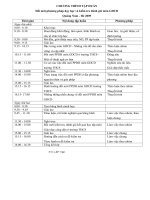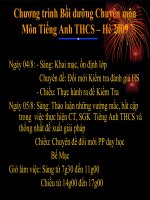chương trình tập huấn
Bạn đang xem bản rút gọn của tài liệu. Xem và tải ngay bản đầy đủ của tài liệu tại đây (727.19 KB, 23 trang )
E12
Top-down &
Bottom-up
processing
Top-down & Bottom-up processing
Production of
spoken discourse
Language
knowledge
Speaking
strategies
BOTTOM-UP
Pragmatics
TOP-DOWN
Knowledge of
presupposition & context
Social knowledge (style) Speaker’s intention
metacognition
Macro-skills
Micro-skills
OUTPUT
(production)
a 2-minute talk on a topic (our
modern house in the future)
Pre-speaking (Unit 8 – FUTURE LIFE) Intensive
Background knowledge of
our future modern house
< listening task
Speakers’ Intention / L. Function
Speaker A: give a talk, explain or
clarify ideas
Speaker B: interrupt and ask for
clarification
Language: intonation
(questions when
interrupting speaker)
Strategy:
-
expressions (interrupting &
returning to the topic)
-
cohesive device (firstly,
secondly,…)
-
fillers (well, really, OK,…)
C. Teaching steps: PPP vs. TBL
PPP < Audiolingualism (mid 1960s)
=> useful in focus-on-form lessons (e.g. grammar)
=> attacked in the 1990s: teacher-centered; Ss learn in
“straight” lines
Presentation Practice Production
no knowledge
providing knowledge
practice
production
=> different from human lang. learning
Task-based learning / instruction
=> learning process < a set of communicative tasks
=> focus on tasks, not structures
=> Ss learn by solving a problem / doing a task
=> student-centered
=> a kind of PPP upside down
Pre-task
Introduction to
topic & task
Language focus
Analysis
Practice
Task cycle
Task, planning,
report
PPP variations & alternatives
⇒
T. and Ss can decide at which stage to enter the
procedure
1
PPP variations & alternatives
=> Trilogy E – S – A
2
Engage = ss’ commitment < T’s initiative
Study = language adoption
Activate = use of language knowledge to do sth.
Trilogy => useful in a skill lesson
=> focus-on-form occurs naturally while ss
hear or read, i.e. Ss analyze their own
language use AFTER a communicative
task
PPP variations & alternatives
=> Trilogy E – S – A
Straight arrows lesson procedure
=> ESA, much like PPP
Boomerang lesson procedure
=> EAS, more task-based









